D. Ragsdale and E. Radcliffe
Department of Entomology, University of Minnesota
Introduction
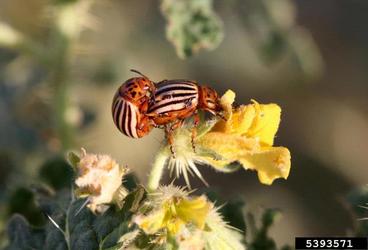
The Colorado potato beetle, Leptinotarsa decemlineata (Say), is a major pest of potato, Solanum tuberosum L., in commercial production and home gardens in Minnesota. Larvae and adults both feed on foliage and if left untreated, complete defoliation of plants is possible.
The Colorado potato beetle was first recognized as a pest of potato in Colorado in 1859 after settlers introduced potatoes into the insect’s native range of the eastern Rocky Mountains. The native host for this insect is a relative of potato, buffalo bur (Solanum rostratum). It took the beetle about 30 years to adapt to potato. But, once Colorado potato beetles had adapted to feeding on potato, the beetles migrated to the east using potatoes grown in farms and gardens throughout the Great Plains and Ohio River Valley. On average, the Colorado potato beetle expanded its range eastward approximately 85 miles per year, reaching the East Coast by 1874. The insect has since become established in Europe and spread eastward to the Urals and Turkey. Potato growers have struggled to control this insect since 1865 when the first broad-spectrum insecticide, Paris green (lead arsenate), was dusted onto potato leaves to protect the foliage from Colorado potato beetles.
Biology & Life Cycle
Adult Colorado potato beetles are about half the size of your thumbnail, oval in shape, and are a yellow-orange color with 10 narrow black stripes on the forewings (elytra). The adult Colorado potato beetle overwinters in the soil either in the potato field itself or in field margins. In Minnesota, the beetle overwinters most successfully in windbreaks and other wooded areas surrounding potato fields. The following spring, adults begin to emerge at about the same time potatoes emerge. Adults feed for a short while in the spring, then begin to mate and lay clusters of 10 – 30 yellow eggs on the underside of the leaf.
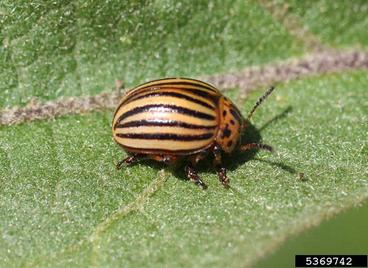
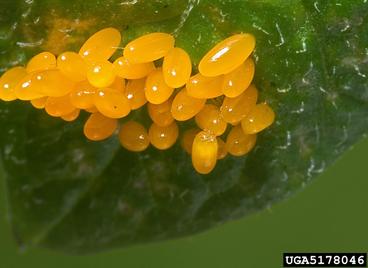
Larvae molt four times getting progressively larger each time. Over 75% of the defoliation caused by the immatures occurs during the last (4th) larval instar. Females typically lay 350 or more eggs during their lives that can last several weeks. The Colorado potato beetle has few natural enemies, and those that do feed on the eggs, larvae, pupae, or adults have little impact on the Colorado potato beetle populations. Eggs hatch within 1-2 weeks, depending upon temperatures (Table 1). Larvae remain aggregated near the egg mass when young but begin to move throughout the plant as that leaf is consumed.
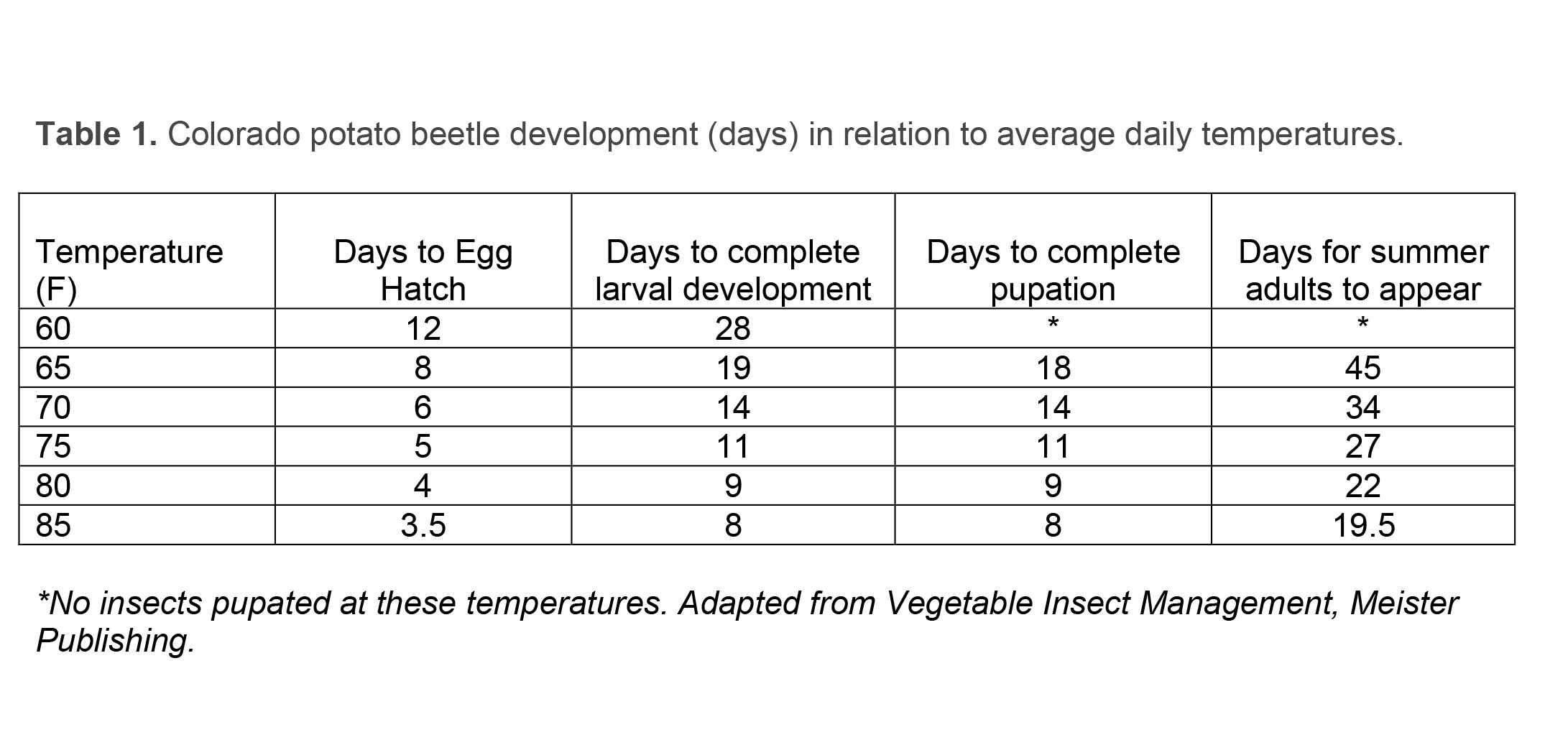
Young larvae are brick red with a black head capsule while 3rd and 4th instar larvae are pink to salmon colored with a black head capsule. The sides of the larvae have two rows of dark spots. Larvae can complete development in as little as 8-10 days if the average temperatures are in the mid 80’s while it will take over a month if temperatures average near 60 F. The fourth instar larvae eventually drop from the plant, and burrow into the soil to pupate.
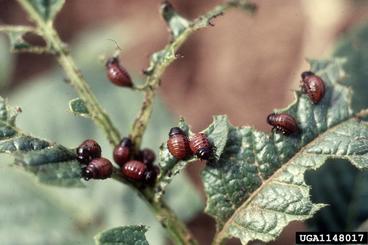
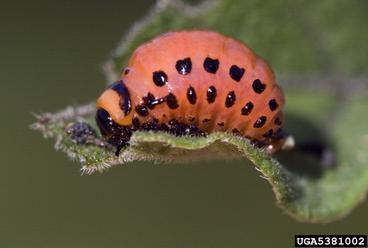
Summer adults begin to emerge in 1-3 weeks following pupation. In southern and central Minnesota, there is generally a partial second generation. Which is to say, that some of the summer adults feed only briefly then migrate to the field margins, windbreaks and wood lots where they burrow into the ground to overwinter. Other summer adults will feed voraciously, mate, and lay eggs. The primary trigger that determines whether individual beetles mate or go into reproductive dormancy is daylength at the time of adult emergence. By mid summer, a potato field can have all stages of Colorado potato beetles, eggs, larvae and adults. You can tell if you have overwintering adults or summer adults by looking at the hind or membranous wings. The overwintered adults have a smoky-orange cast to their wings with distinctive orange veins. The hind wings of the summer adults are clear.
Management - Commercial Growers
The Colorado potato beetle is one of the few “super” pests in agriculture. This species has developed resistance to most insecticides. Care must be used when targeting Colorado potato beetles to select an effective insecticide. You should also recognize that once you have to increase the rate to get adequate control, resistance to that insecticide is likely present in the population. Commercial growers have a number of insecticides that perform well. Fortunately, many of the newer insecticides have a unique mode of action giving growers the opportunity to delay the onset of resistance by rotating chemical classes. If growers carefully select insecticides for Colorado potato beetle control, these products should remain effective for years to come. Repeated use of the same insecticide or other insecticides from the same chemical class will speed development of insecticide resistance. Slowing the onset or even preventing insecticide resistance is called resistance management and all growers should practice some form of resistance management.
Resistance Management
There are several key components of any resistance management program. First and foremost is to not repeatedly use the same insecticide or other insecticides having a similar mode of action to control Colorado potato beetles on the same farm in successive years. In fact, growers should not use the same insecticide to control the overwintering generation and the summer adults and any larvae they produce (2nd generation) in a given growing season. Historically, it has taken from 4 to 10 generations of repeated exposure to the same or similar insecticide for resistance to occur in Colorado potato beetles. In Minnesota this can mean 3-5 years in southern and central Minnesota where there are 2 generations per year and 4-10 years in the Red River Valley where Colorado potato beetles have a single generation most years. A good “rule of thumb” is if an insecticide performed well for you against the overwintering adults and young larvae don’t use it on the summer adults or again the following spring. Switch insecticides and if possible use an insecticide from a different chemical class that has a different mode of action. Review the Midwest Vegetable Production Guide for updated insecticide information.
Cultural Control
Crop rotation is an effective method of reducing your risk to Colorado potato beetles. The greater distance a potato field is located from a last year’s potato field, the later in the season the field will become colonized with beetles, greatly reducing the potential for damage. Colorado potato beetles cannot fly unless temperatures reach 70 F. In early spring in Minnesota, daytime temperatures can be substantially below 70 F effectively making beetles walk from the overwintering site to locate a potato field.
Chemical Control
Commercial production of potatoes is nearly impossible without using insecticides to control Colorado potato beetles. Commercial growers have the option of using systemic insecticides applied to the soil or seed at planting or apply insecticides to foliage after crop emergence. Using a systemic insecticide at planting is justified if there is a history of beetle treatment each growing season. If beetle pressure is not always severe, foliar applied insecticides can be the better choice because that permits assessment of beetle pressure before deciding on treatment. Also, invasion of a field may occur from one side of the field and treating field edges or “hot spots” is an option available to those who use a foliar applied insecticide.
All insecticides are most effective on very young larvae. Eggs and pupae are not susceptible to chemical control and adults can be difficult to control. Targeting application toward young larvae helps prevent damaging populations and allows resistant adult beetles to mate with susceptible beetles keeping selection pressure for insecticides resistance low. If sprays are targeted against overwintering adults, the only survivors will be resistant individuals. When resistant individuals mate, their offspring are resistant thus fixing the resistance gene in the population. Once resistance has become fixed in a population, reversion to susceptibility occurs only after many generations of non-exposure and may never revert to pre-exposure levels.
Foliar materials are best applied between 15 and 30% egg hatch for best control. A second foliar application may be necessary if egg laying continues over an extended period. You can predict 15-30% egg hatch by flagging 100 egg masses in the field and checking them daily. Alternatively, insecticide application could begin when egg hatch has occurred on 5-10% of the plants. Waiting to spray until beetles are in the late 3rd and early 4th instar is not a wise strategy. Large larvae are difficult to control and since the 4th instar larvae are responsible as much as 75% of the feeding damage, earlier treatment is usually necessary to prevent economic damage. Determining if a beetle population is large enough to treat is not easy. Potatoes can tolerate up to 30% defoliation prior to flowering but only 10% defoliation at the onset of tuber initiation. Failure to control the first generation larvae may translate into large numbers of summer adults that emerge and feed during the critical tuber initiation and tuber bulking stage.
It is particularly important in potatoes that insecticides used to control Colorado potato beetle don’t flare aphids. Multiple applications of foliar insecticides to control summer adults and larvae of Colorado potato beetle are commonly associated with aphid outbreaks. Insecticide applications disrupt the predators and parasitoids that would otherwise hold aphid populations in check. Additionally, when fungicides are used repeatedly to prevent foliar diseases such as late blight in combination with insecticides, aphid populations can build to such high levels that foliage will die. By keeping insecticide applications at a minimum, green peach aphids generally will not reach pest status. Repeated use of insecticides for either Colorado potato beetle or potato leafhopper control can flare green peach aphid populations.
Management - Home Gardeners and Certified Organic Growers
For homeowners, the general use insecticides that are available locally are largely ineffective because of widespread insecticide resistance of the Colorado potato beetle. An example of this is the insecticide Sevin (carbaryl). Insecticides derived from botanical sources, e.g., rotenone and neem, may be available from catalogs or larger nurseries and greenhouse supply centers. The botanical insecticides can give adequate control of Colorado potato beetle provided they are applied frequently and young larvae are targeted. In general, botanical insecticides break down rapidly and need to be reapplied frequently and generally give poor control of large larvae and adults. There are a few insecticides that are derived from bacterial toxins. One available to the home gardener is a product from Bonide, Colorado potato beetle beater.
Cultural control practices such as crop rotation is largely ineffective because of space consideration in home gardens. Planting an early maturing variety will also allow you to escape much of the damage caused by adults emerging in mid-summer. Check you seed catalogs for varieties that mature in less than 80 days. Yield on early maturing varieties are not as large, and often these varieties do not store as well as the popular Russet Burbank potato. Mechanical destruction of the insects is always an option and depending upon the size of the garden can be effective. Remember to look on the underside of leaves for egg masses and remove or crush the egg masses when found.
If you choose to use an insecticide to control Colorado potato beetles, the same resistance management strategies apply to home gardeners as they do to commercial growers.
All insecticides are most effective on very young larvae. Eggs and pupae are not susceptible to chemical control and adults can be difficult to control. Targeting application toward young larvae helps prevent damaging populations and allows resistant adult beetles to mate with susceptible beetles keeping selection pressure for insecticides resistance low. Foliar materials are best applied between 15 and 30% egg hatch for best control. Because eggs may be laid over a several week period, repeated application is necessary for good control. Waiting to spray until beetles are in the late 3rd and early 4th instar is not a wise strategy. Large larvae are difficult to control and since the 4th instar larvae are responsible as much as 75% of the feeding damage, earlier treatment is usually necessary to prevent severe crop loss. Potatoes can tolerate up to 30% defoliation prior to flowering but only 10% defoliation after flowering.
Altogether, control of Colorado potato beetle in the home garden can be a challenge, but not an impossible task. Armed with knowledge of the insect’s biology, damage potential and available control options should allow you to successfully produce a crop.